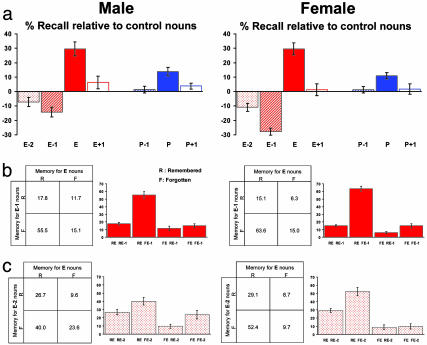Fig. 4.
Women display greater emotion-induced memory impairment than men. (a) Recall performance relative to control nouns (%) is plotted for male and female subjects collapsing across the placebo group in Exp. 2 and the control group in Exp. 3. A gender (male, female) × oddball type (emotional, perceptual) × position (oddball-1, oddball, oddball + 1) 2 × 2 × 3 ANOVA across these two groups from Exps. 2 and 3 revealed a significant main effect of position (F1.9, 21.3 = 72.8 P < 0.001), a significant gender × oddball type interaction (F1.0, 11.0 = 9.1 P < 0.05), a significant oddball type × position interaction (F1.4, 15.5 = 31.6 P < 0.001), and a significant gender × oddball type × position interaction (F1.4, 15.6 = 4.7 P < 0.05). A gender × position 2 × 3 ANOVA restricted to the emotional factor revealed a significant main effect of gender (F1,11 = 6.1 P < 0.05) and position (F1.4, 15.9 = 64.7 P < 0.001) and a significant gender × position interaction (F1.6, 18.1 = 4.4 P < 0.05). Post hoc independent t tests revealed a significant gender difference only for the E-1 nouns (P < 0.005 two tailed). (b and c) Reciprocal codependency of memory for E nouns and E-1 nouns (b) and E and E-2 nouns (c) for males and females, as for Fig. 2b. A significant female vs. male difference for codependency between E/E-1 memory (χ2 = 6.1; P < 0.05) and E/E-2 memory (χ2 = 23.0; P < 0.001) was observed, with women showing a greater remembered E and forgotten E-1 (RE FE-1) and RE FE-2 effect.

